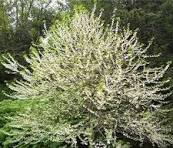Examples of native trees to plant in Polk County
Published 11:35 am Friday, March 1, 2024

- Carolina Silverbell is one of the prettiest native trees to be found
|
Getting your Trinity Audio player ready...
|
With spring quickly approaching, this is a great time to start thinking about planting. Native plant enthusiasm is growing across the country, especially in our community.
One example of a great native tree to plant is the Carolina Silverbell (Halesia Carolina). It is one of the prettiest native trees to be found; however, this pretty one can be finicky to transplant or plant. The white bell-shaped flowers are lovely. This tree is typically a small-scale 20-30’ tree, but larger specimens have been found. It can also be grown as a large multi-canned shrub.
Serviceberry (Amelianchier) is another great choice. The fruit of this small-scale tree, or large shrub, is one of our Eastern Bluebird’s favorite foods. It’s not a showy bloomer, but it has a really pretty layered effect in the foliage. The Southern Crabapple is a native crabapple with pink blooms that are as fragrant as any rose! It makes a lovely specimen or ornamental tree, is long-lived, and is adaptable to moist and dry conditions.
Pagoda Dogwood (Cornus Alternifolia) is also a lovely choice for a woodland or shadier garden. A small-scale tree holding yellowish-white flowers in clumps, the tree has an almost year-round interest, with reddish-purple or reddish coppery coloration for new leaves and fall color, then green leaves in tiered horizontal branches during the growing season. Bluish-black berries provide winter interest.
Sourwood (Oxydendrum Arboretum) makes an excellent understory tree, or it can be planted in small groups in a woodland garden, but it can also tolerate some sun. Sourwood is well used in native pollinator or butterfly gardens. Beautiful red foliage makes it a standout along our highways.
Bald Cypress (Taxodium Distichum) is a tough and hardy tree, a deciduous conifer, that adapts to a wide range of conditions. It is noted for the red russet fall color of its lacy needles. It is a large slow-growing, long-lived tree, often reaching 40 to 100 ft. It grows best in full sun or part shade.
Lastly, wouldn’t it be great if we could replace the Bradford Pears across from Hatch Mill (Milliken) with some better choices? John Vining’s two top choices for that would be a “Constellation Dogwood,” a hybrid between the native flowering dogwood and Asian Kousa Dogwood, or a “Merlot” Redbud, believed to be a natural cross between two different types of Redbud, the “Texas White” and the “Forest Pansy.” Sourcing for many of the above trees can be a great plant hunt!
It’s important to note that we need to take care of the trees that we already have in our yards and community. Beware of kudzu and strive to eradicate it as soon as possible. Monitor your older trees for weakness and diseases, and find a good arborist to help and advise you. I just had “Upstate Arborist” find Ambrosia Beetles in three of my mature sugar maples that had all died and had to be removed.
To learn more, visit beautifulfoothills.org.

Submitted by Denny Crowe, Polk County Appearance Commission





